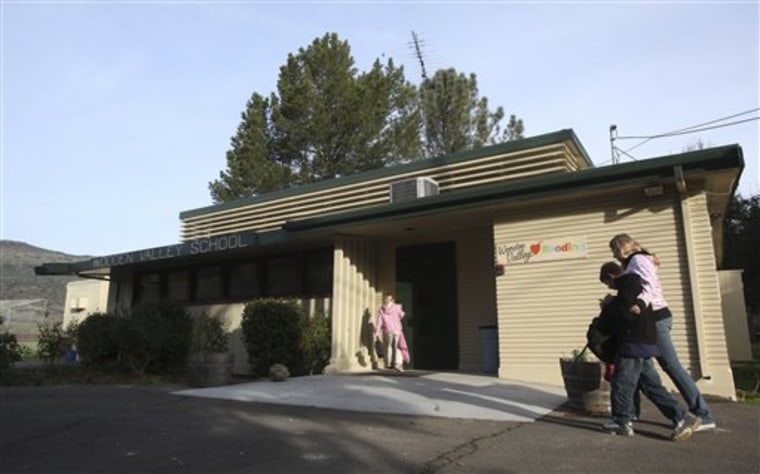In this rustic corner of California wine country, parents are fighting to prevent the closure of a one-classroom school established before the Civil War.
Near Las Vegas, families are trying to rescue two elementary schools with dwindling enrollment. And in a rural area outside San Diego, a 60-year-old schoolhouse closed because it had just seven students.
Rural schools such as these are being threatened as the economy forces deep cuts to education. Districts nationwide are preparing to shut down many campuses, and small, isolated schools are vulnerable because they serve fewer students and cost more per pupil to operate than larger schools.
"All over this country, the pressure is on to close rural schools," said Marty Strange, policy director of the nonprofit Rural School and Community Trust in Arlington, Va. "They are a target in these hard economic times."
Among the schools targeted is Wooden Valley Elementary School, which has one teacher, one teaching assistant and 20 students from kindergarten to fifth grade. Surrounded by ranches and vineyards in the rolling hills of Napa Valley, it is one of the oldest one-room schools still operating in California.
An icon of American culture depicted in the television show "Little House on the Prairie," the one-room schoolhouse dominated education before buses allowed children to attend schools more than walking distance from their homes.
A century ago, there were more than 200,000 one-teacher schools in the country, but that number dwindled to 335 in 2006, according to the National Center for Educational Statistics.
'Difficult straits'
In rural San Diego County, enrollment at Palomar Mountain School was only seven students when it closed last year after six decades.
Outside Las Vegas, school officials recently postponed a vote to close Lundy Elementary and Goodsprings Elementary after parents protested. Both schools have fewer than 10 students, and Goodsprings is listed on the National Register of Historic Places.
In Northern California, Wooden Valley has staved off closure many times before, but parents worry that the state's budget crisis is so severe that it could finally shutter a school that has existed in some form since the 1850s.
District officials have proposed closing their two smallest schools to help offset $10 million in cuts to its $115 million annual budget. The 17,000-student district also is looking into increasing class sizes, shortening the school year and laying off nearly 10 percent of its 900 teachers.
"We're in difficult straits," Superintendent John Glaser said.
Parents are raising money and lobbying district officials to keep open the old school, where children of different ages learn and play side-by-side. A decision is expected later this month.
"By closing our school they are taking away our way of life," said Wanda Berger, the school's PTA president and mother of two students. "It's the way our founding fathers went to school, and education was pretty strong back then."
California schools, which rank near the bottom nationally in per pupil spending, are preparing to make drastic cuts after Gov. Arnold Schwarzenegger and the Legislature last month reached a budget deal that reduces K-12 education spending by $8.6 billion — more than 10 percent — through June 2010.
"These cuts are completely devastating," said Bob Wells, executive director of the Association of California School Administrators.
California school districts are set to increase class size, close libraries, eliminate sports programs, scrap electives such as art and music, and lay off tens of thousands of employees.
The districts are also preparing to close dozens, possibly hundreds, of schools with low or declining enrollment and send the displaced students to other campuses.
"We can't afford to keep open all the schools we got," said Scott Plotkin, who heads the California School Boards Association.
Does size matter?
School officials say small schools like Wooden Valley are not cost-effective and that students can benefit from the resources of a larger school.
But advocates say that when rural schools close, children face longer commutes and parents become less involved. They also note that studies show that small schools lead to better grades and lower dropout rates.
"If we really cared about raising student achievement, we'd be creating more small schools, not less," Wells said.
The 20 students at Wooden Valley attend class in a schoolhouse built in the 1950s near the original wooden schoolhouse.
Teacher LeeAnn Ohlandt said it is a challenge teaching students at six different grade levels, but she encounters far fewer behavior problems than at her previous school.
"I love it," Ohlandt said. "I've become part of their families. I get to see these kids grow."
Although Wooden Valley does not have the resources of a larger school, parents say their children learn better social and communication skills and are not exposed to the teasing and bullying common in many schools.
Korinne Norlund, who has six children attending Wooden Valley, said she would home-school her kids if Wooden Valley closed.
"It's a very safe environment emotionally," she said. "There's no ridicule of any kind. It's just something you don't get in the average public school."
